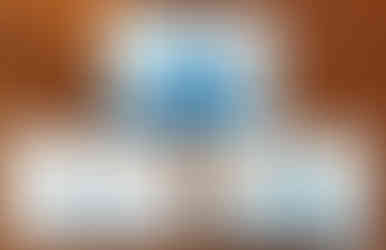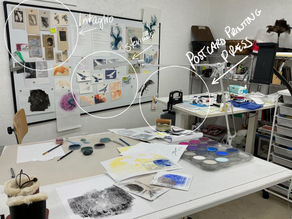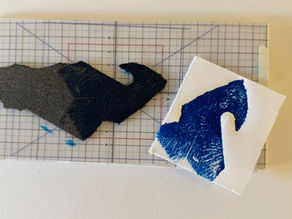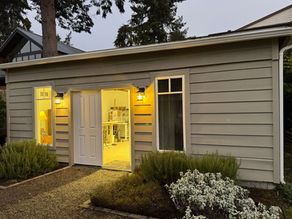The Postcard Printing Press
- Caroline Clarke

- Mar 19
- 4 min read

I was in DC last week—in the streets, yes, but also at my kitchen counter with a jar of Akua intaglio ink, a box of small papers, and the tiny (but mighty) Postcard Printing Press. The press is new to me, and I was keen to try it out.
I walked through the National Mall on my first day. Instead of tracing the roofline of the Smithsonian Castle, my gaze scanned the street gutters and sad flower beds. There, I found bits of plastic, fabric, string, wadded-up tape, feathers, leaves, and a flattened sardine can.
Most promising.
All these objects would be inked and run through the tiny printing press attached to my kitchen counter.

A while back, I’d watched the tutorial for the press. I rewatched the first bit again. Surely enough to get started.
I opened the jar of ink.
Akua Intaglio Ink
The first prints, consisting of a leaf and a piece of old shoe leather, were made on painted Bristol paper, Strathmore Artist Tiles, and cardstock. The ink sat shiny on top of the paper. The second batch of prints was created using the intaglio printing method on dampened Fabriano paper.
All prints were left to dry.
The next day, the first batch of prints was still wet. What? The second batch of prints, made on the dampened paper, also had taken on heavy ink but was dry.
Time to consult the label on the jar.
“Akua Inks only dry through absorption; they will not dry
on the printing plate. Cleans up with soap and water.”
In retrospect, the clue was in the name — Akua Intaglio ink.

Tip: Clean off the press bed soon after printing—use Windex! Neither soap and water nor Simple Green work on the plastic press bed and plate. (Baby wipes work wonders for cleaning hands.)
Intaglio printing
Intaglio printing is always done with dampened paper. Modern intaglio is wide open — inking almost any textured surface to create the print. Its promise, for me, lies in the beautiful impressions that the printed object leaves on the paper — the tactile quality of the print — and the soft image that is transferred.
First, I tore the paper to size and soaked the sheets in water for 30 minutes. Then, using small pincers, I transferred the paper onto a dish towel and pressed it to remove excess water, ensuring no sheen remained. Next, with the brayer and my fingers, I inked various objects I had gathered from my walk, selecting those that would create an indent.
And ran them through the press.
I used water-mixable oil paints for subsequent prints — adding yellow and red to the pthalo blue intaglio ink.
Tip: Carefully calibrate the press's pressure. If it’s too tight, it can break the fibers of the paper—like the ones here. Adjust the pressure as the bed begins to roll through the press. If it rolls through too easily, tighten it; if it gets stuck, loosen it.
These first explorations provided a glimpse into the art of printmaking with texture, shapes, values, and edge. The tiny format meant iterations were quick to do.
I figured out a few things in the process:

Water-mixable oil paint resolves the drying issue and allows me to print on various paper types.
Found objects can be layered and printed, then printed again. This produces surprising results, which in turn suggest subjects and stories.

Two sheets of paper—one on the bottom, the other on top of what is to be printed—give different results. The top paper comes away with an indent, while the bottom remains flat.
Running the inked-up object twice through the press — without re-inking — gives lovely changes in values and textures.
This red print was built with odd bits of used packing tape and plastic strands mounted on a found metal plate. The ink was applied generously, and the excess was wiped off the plate.
Smooth metal surfaces, like this template, print crisply on Bristol paper. You know what you’re getting.
Soft organic material, like this fraying nylon strap, produces a variety of edges.

Ink the plate first, then place an object on top. This blocks sections from printing, which preserves the white of the paper.
Organic material on the damp intaglio paper creates a soft print, with the ink bleeding and transitioning. This yellow one is reminiscent of the woods.
Intaglio printing provides all kinds of surface textures.
And what about the Postcard Printing Press itself?
It travels well. I’ll pack it for my next trip to DC -- maybe even make a postcard or two.

A closer look: That flattened sardine can was only the beginning
The hunt for tiny detritus to press into service (pun intended) enlivened and extended my walks. Down 7th Street NW past the National Archives building inscribed,
This Building Holds in Trust the Records of Our National Life and
Symbolizes Our Faith in the Permanency of Our National Institutions.
Words to ponder.
Turning at the skating rink, walking past the Natural History Museum, then north, up 12th Street to Dick Blick’s for a few printing supplies. Turning east to the Convention Center, where the Satellite 2025 Conference & Exhibition was last week. Could I get in? Nope — the price tag was for industry insiders only.
Just across the street, however, is the historic Carnegie Library (and Apple Store) — a stunning building that is free for everyone. Opened in 1903, it was the city’s first library and served as DC’s Central Public Library for 70 years. It then briefly became the City Museum of Washington at the end of the 1990s (I remember this incarnation). Ultimately, in need of renovations, Apple invested $30 million in 2016, reopening its doors in 2019.

Finally, I turned south through Chinatown, past the National Portrait Gallery (remember the animal sculptures on the top floor that stand still for sketchers?), and then home for afternoon tea — my backpack filled with found objects.


























































Your exploration of intaglio printing with found objects is truly inspiring; it’s amazing how everyday scraps can transform into such beautiful, textured prints. The Postcard Printing Press seems like a fantastic tool for artists on the go. For those looking to blend creativity with practicality, this approach could even extend to cheap business card printing in UAE. Imagine unique, hand-printed business cards made with local textures and materials! Your tips on ink and paper choices are invaluable.
Such a lovely tutorial Caroline and meandering through DC sounded, well, relaxing. Who would have thought? Since I have my printing background (offset), I truly appreciated the steps and missteps you took to get the your final results. Thank you!